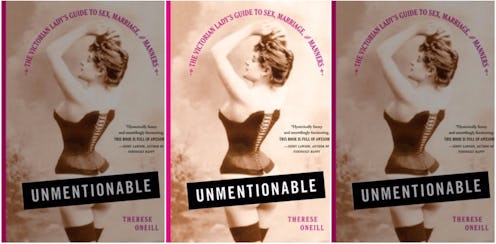
Have you ever read a love scene in a historical romance novel and wondered, "But what about the smell? What do they do when they're on their periods??" Of course you have, because let's be real — in Victorian times, women did not bathe terribly often, and their undergarments were completely crotchless. In Unmentionable: A Victorian Lady's Guide To Sex, Marriage, and Manners, Therese Oneill lifts the veil on romantic notions about olden times to unearth some pretty horrifying truths about hygiene, sex, menstruation, and beauty in the 19th Century. Spoiler alert: None of it is pretty.
"The job of most books is not to show you the real gross stuff," author Therese Oneill tells Bustle. "You come for the romance. You don't come for that." But Oneill wanted the gross stuff. She began researching "rare history" in college, combing through old sexual health manuals as an undergrad. Then, after watching the Demi Moore version of The Scarlet Letter, she began asking questions about the time period. Questions like, "Why the hell doesn't Demi Moore have hair on her armpits? How did women shave? Did women shave?" She started doing some research. "Once you open that door, it spiderwebs," she says. "One thing leads to another."
Before she knew it, the idea for Unmentionable was born.
The book is narrated by an unnamed woman, a barmaid-esque fairy godmother who guides the reader, a time-traveler from modernity, through adolescence, marriage, and motherhood in Victorian times. The narrator's advice is peppered with excerpts from the published works of 19th-Century scientists, doctors, etiquette experts, and that special brand of people who seem to have an opinion about everything. As you'll quickly learn, these "experts" would more accurately be described as "quacks" who have absolutely no idea what they're talking about.
"I cherry-picked the lunatics," Oneill says. "Lunatics were the bestsellers. There were actual legitimate medical doctors doing research and publishing it, but their stuff didn't get bought. [The lunatics'] books sold out printing after printing after printing."
The information provided in the book — all completely factual — is supplemented by the hilarious, irreverent musings of the unnamed narrator. What results is a positively hysterical romp through 19th-Century womanhood. In one particularly memorable excerpt, Oneill describes how Victorian women struggled to find places to dry their jelly rags (menstrual rags) after washing:
[You wouldn't store them] on the clothesline, that’s for certain, unless your home adjoins an abattoir and you can pass them off as tiny butcher’s aprons (you would never, ever be able to completely bleach a reused sanitary napkin back to whiteness, and there would be no mistaking its true nature). And not over the fireplace either, for these reminders of the curse of Eve were hidden from all members of a household who didn’t use them. Even if you were alone during the day, you couldn’t be sure a neighbor wouldn’t call at your door, watching you through the window as you pinballed around your parlor, hiding menstrual rags like a meth head during a police raid.
This bit of information is supplemented by a image of a girl sitting with a book. A shocked expression on her face indicates an unexpected visitor. The caption reads: "Oh, no! A knock in the darkness! It could be a murderer! He’ll see my jelly rags!"
Oneill notes that it would easy to go "mean" in a book like this. But she had no interest in bullying the women of the past for the seemingly insane things they did in the name of health and beauty (like squirting deadly nightshade into their eyes to dilate the pupil for a "languishing, half-sentimental, half-sensual look").
"In 115 years, we're going to look like complete idiots, too," she says. "I mean, we have acid facial peels, stiletto heels, Botox. It's not better than smearing mud on your face. I'm only making fun of the real idiots — the blowhard doctors who thought they were direct descendants of God."
These "blowhards" sometimes did things that were unfathomably awful. In the final section of the book, Oneill introduces readers to Dr. John Harvey Kellogg, a man who waged war against masturbation. One of his tactics in the fight to stop self-pleasure? "He did random clitorectomies on young girls," Oneill says. "Or he would blister boys' penises with carbolic acid. He never did follow-ups."
"He's the only person from the book I truly hate," she adds.
For Oneill, there's a stark difference between misinformed and evil. While Dr. Kellogg would probably qualify as the latter, many of the other experts quoted in her book were simply doing the best they could with the information they had. The hilarious extent of their misinformation is a jolting reminder that we don't know everything either. In a matter of decades, we'll probably be the ones with egg on our face — and not for cosmetic purposes.
Unmentionable by Therese Oneill, $22.50, Amazon